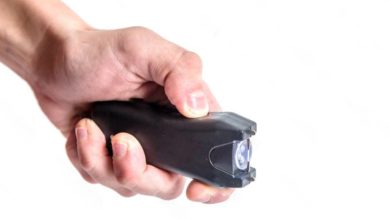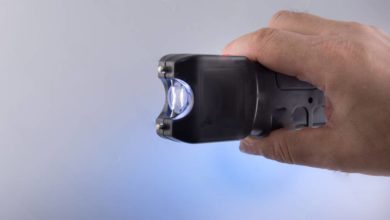What Stun Gun Do Police Use?
KEY TAKEAWAYS
Stun guns are generally classified as non-lethal weapons in most states in the U.S., designed for self-defense and capable of causing serious injuries but not intended to be deadly.
Regulations regarding the use and ownership of stun guns vary significantly by state. While most states allow their use for self-defense, certain states have specific restrictions or licensing requirements.[1]
Many states require police officers to undergo specialized training and certification for the use of stun guns, ensuring they are used appropriately and safely.
Common models of stun guns used by law enforcement include the Taser X26P, Taser X2, and Taser 7, each chosen based on specific operational needs.
In most states, civilians do not need a permit to carry a stun gun. However, some states like Michigan, Illinois, Wisconsin, and Indiana require a license or permit.[2]
Stun guns are illegal in Hawaii and Rhode Island, highlighting the diversity in state laws regarding these devices.
For law enforcement, the use of non-lethal force is a critical aspect of maintaining public safety while ensuring the well-being of both officers and civilians. Among the various tools at their disposal, stun guns have emerged as a prevalent choice. Stun guns, commonly known as Tasers, are an integral part of law enforcement’s arsenal. They provide a non-lethal means of subduing a suspect, minimizing the risk of serious injury.
This comprehensive exploration delves into the types of stun guns used by police forces, their operational methods, and the strategic context in which they are employed.
What Stun Gun Do Police Use?
The most widely used model in many police forces is the Taser X26P, renowned for its effectiveness and reliability. Equipped with advanced features like laser targeting and an enhanced power magazine, the X26P ensures precise control and safe deployment.
Key Features Of The Taser X26P
- Advanced Electro-Muscular Disruption (EMD): This technology temporarily overrides the central nervous system, incapacitating the target without causing permanent harm.
- Laser Targeting System: Enhances accuracy, allowing officers to aim with greater precision.
- Enhanced Power Magazine (EPM): Provides a longer battery life and additional cartridge storage, ensuring readiness in various situations.
Types Of Stun Guns Used By Police?
While the Taser X26P is prevalent, other models also find use in law enforcement:
- Taser X2: Known for its dual-shot capability, providing a backup shot if the first fails.
- Taser 7: The latest model with improved probe performance, enhancing effectiveness at close and extended ranges.
- Pepperball Launchers: Used for crowd control situations, these launchers shoot pellets containing a pepper spray powder, effective at a longer range.
Regulations Regarding Police Stun Guns Use
State Laws Regarding Stun Guns
Regulations around the use of stun guns by police in the United States vary significantly by state. While stun guns are generally classified as dangerous weapons and are legal in most states, their use by law enforcement is subject to specific state codes and regulations.[1]
Most states consider them non-lethal, designed for self-defense but capable of serious injury. Additionally, while legal in many states, stun guns are strictly for self-defense, and their misuse is criminal. Contrary to popular belief, carrying a stun gun typically does not require a permit, except in states like Michigan and Illinois.[2]
For example, they can only be used for self-defense, the user must not have a felony record, and the user must be an adult. Some states, like Illinois, Wisconsin, Indiana, and Michigan, require a license to own a stun gun.
Fast Facts
In the United States, no state allows minors (individuals under the age of 18) to own stun guns or tasers.
Differences In The Types Of Stun Guns Used By Law Enforcement Agencies
Law enforcement agencies use a variety of stun guns, each with its own set of features and functionalities. The most commonly used models include the Taser X26P, Taser X2, and Taser 7. The Taser X26P is known for its reliability and advanced features like laser targeting. The Taser X2 offers a dual-shot capability, providing a backup shot if the first fails. The Taser 7 is the latest model with improved probe performance. Each type is chosen based on specific operational needs and the context in which it will be used. The selection of a particular model by a law enforcement agency often reflects its policies, the nature of the duties of its officers, and the typical scenarios they encounter.
Frequently Asked Questions
Here, we’ve answered some of the most common questions about the types of stun guns police use to help you better understand this.
Are stun guns considered lethal weapons?
No, most states classify stun guns as non-lethal weapons intended for self-defense, capable of causing serious injuries but not designed to be deadly.
Do police officers require special training to use stun guns?
Yes, many states mandate that police officers undergo specific training and obtain certification for the use of stun guns, ensuring proper usage and safety.
Using Stun Guns In Law Enforcement
Stun guns represent a critical element in the toolkit of modern law enforcement, bridging the gap between effective law enforcement and the commitment to non-lethal force. Understanding the nuances of their use, from regulatory frameworks to types employed by various agencies, is key to appreciating their role in policing. As technology evolves, so will the capabilities and applications of stun guns, continually enhancing public safety and officer effectiveness in maintaining law and order.
Discover more self-defense tools by checking out our guide on night watchman stun guns. Learn more by visiting Security Forward and exploring our comprehensive resources on personal security solutions.
- “Stun Gun Laws by State: The Legal Guide for 2023.” Lawrina, 2023, https://www.lawrina.org/blog/en/stun-gun-laws-by-state.html.
- “Stun Gun Laws & Regulations in the US: 2023 Legal Guide.” JusticesNows, 16 Jan. 2023, https://www.justicesnows.com/stun-gun-laws-regulations-in-the-us/.



